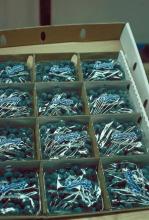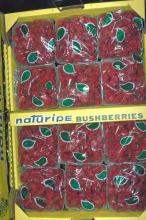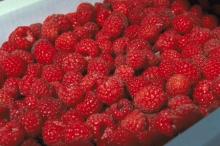Maturity and Quality
Generally based on berry surface color. Soluble solids and titratable acidity may also be considered. All berries should be harvested near ripe as eating quality does not improve after harvest.
- Appearance (color, size, shape, freedom from defects)
- Firmness
- Flavor (soluble solids, titratable acidity and flavor volatiles)
- Nutritional value (Vitamins A & C)
Postharvest Handling and Storage
Blackberry and raspberry: (2-5 days) 0±0.5°C (32±1°F), blueberry (1-2 weeks)
Cranberry: (2-4 months) (37±2°F)
| Temperature | ml CO2/kg·hr | ||||
|---|---|---|---|---|---|
| Celsius (Fahrenheit) | Blackberry | Blueberry | Cranberry | Raspberry | |
| 0° (32°) | 11 | 3 | 2 | 12 | |
| 10° (50°) | 31 | 9 | 4 | 49 | |
| 20° (68°) | 78 | 34 | 9 | 100 |
To calculate heat production multiply ml CO2/kg·hr by 440 to get Btu/ton/day or by 122 to get kcal/metric ton/day.
Blackberries and raspberries do not respond to ethylene by stimulation of ripening processes. Blueberries are climacteric fruit and respond to ethylene; but should be harvested near to full ripe as flavor does not improve after harvest. Removal of ethylene from storage air may reduce disease development.
90-95%
0.1-1.0 µl/kg·hr at 5°C (41°F)
Modified atmosphere packaging for shipment with 15 to 20% carbon dioxide and 5 to 10% oxygen reduces the growth of Botrytis cinerea (Grey Mold Rot) and other decay causing organisms, and reduces the respiration and softening rates of blueberries, raspberries and blackberries thereby extending postharvest life. Whole pallet covers and consumer packages for containment of the modified atmosphere are commonly used. Prompt cooling should be done before atmosphere modification.
Disorders
Shriveling/Water Loss. Berries are quite susceptible to water loss which results in fruit shriveling and loss of gloss. Maintenance of 90 to 95% relative humidity around the fruit and storage at optimum temperatures will minimize water loss.
Leakers. Refers to berries which begin to leak fluid to the exterior; thought to be due to physiological breakdown.
CA-Related Disorders. Exposure of berries to <2% oxygen and/or >25% carbon dioxide can cause off-flavors and brown discoloration, depending on cultivar, duration of exposure, and temperature.
Chilling Injury of Cranberries. Occurs when fruit are exposed to the temperature of <3°C (37°F). Symptoms include dull appearance, rubbery texture, and increased susceptibility to decay.
Diseases are the greatest cause of postharvest losses in berries. The best methods for disease control are:
- Prompt cooling
- Storage at the lowest safe temperature
- Preventing physical injury to the fruit
- Shipment under high carbon dioxide
In addition, care should be taken to keep diseased or wounded berries out of packages as rot can spread from diseased to nearby healthy berries (nesting).
Botrytis Rot (Grey Mold). Caused by Botrytis cinerea is a common pathogen on berry fruit. This fungus continues to grow even at 0°C (32°F), however growth is very slow at this temperature.
Rhizopus Rot. Caused by the fungus Rhizopus stolonifer. Spores of this fungus are usually present in the air and are easily spread. This fungus will not grow at temperatures below 5°C (41°F), therefore temperature management is the simplest method of control.
Special Considerations Cranberry.
There is more fungal decay and physiological breakdown in water-harvested than hand-harvested cranberries, especially if cranberries are kept in the water more than 12 to 24 hours.






